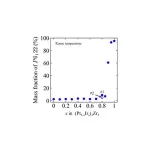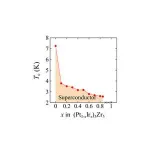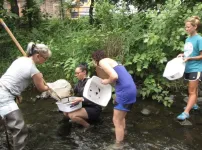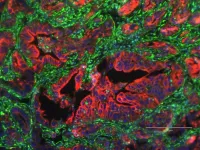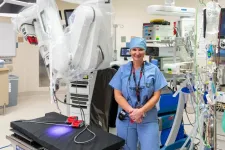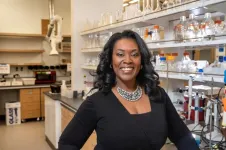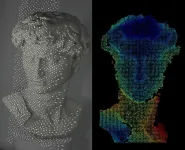Scientists mix and match properties to make new superconductor with chiral structure
Fine tuning crystal symmetry and superconductivity using solid solution methods
2024-02-03
(Press-News.org)
Tokyo, Japan – Researchers from Tokyo Metropolitan University have created a new superconductor with a chiral crystalline structure by mixing two materials, one with superconductivity but no chirality, another with chirality but no superconductivity. The new platinum-iridium-zirconium compound transitions to a bulk superconductor below 2.2 K and was observed to have chiral crystalline structure using X-ray diffraction. Their new solid solution approach promises to accelerate the discovery and understanding of new exotic superconducting materials.
Scientists studying superconductivity are on a mission to understand how the exotic nature of superconducting materials arises from their structure, and how we might control the structure to get desirable properties. Of the many aspects of structure, an interesting recent development is the issue of chirality. Many structures have a “handedness,” that is, they do not look the same in a mirror. An effect of chirality in superconductors is to trigger something called asymmetric spin-orbit coupling (ASOC), an effect which can make superconductors more robust to high magnetic field exposure.
To understand chirality in more depth, however, scientists need more superconductors with a chiral structure to study. The usual route is to search out chiral compounds, check if they are superconducting or not, rinse and repeat: this is very inefficient. That is why a team from Tokyo Metropolitan University led by Associate Professor Yoshikazu Mizuguchi have introduced an entirely new approach. Instead of combing through lists of compounds, they mixed two compounds with known physical properties, a platinum-zirconium compound with superconductivity but no chirality, and an iridium-zirconium compound with a chiral structure, but no reports of superconductivity. By combining elements in a ratio that matches a certain proportion of each compound, they were able to effectively “mix and match” physical properties, coming up with a new material that had both a chiral crystal structure and superconductivity.
The team firstly studied different mixture ratios, finding that at around 80% iridium inclusion, the proportion of chiral crystalline structure (here, the P6122 structure of the chiral iridium-zirconium compound) increases rapidly at room temperature. Cooling samples to low temperatures, they were able to confirm superconductivity up to around 85%. This left a small window where both properties can manifest. Looking at their 80% mixture, they cooled the sample down to around where superconductivity was seen, finding that the proportion of chiral structure increases dramatically. Clearly, their new compound is a superconductor with a chiral structure.
The team also confirmed that the superconductivity arises in the bulk, not from the surface. Their work demonstrates the power of a “mix and match” approach in making new exotic superconductors, a welcome, dramatic boost in the hunt for more materials, and more understanding.
This work was supported by a Tokyo Government Advanced Research Grant (H31-1) and JST-ERATO Grant Number JPMJER2201.
END
ELSE PRESS RELEASES FROM THIS DATE:
2024-02-03
(Millbrook, NY) Cary Institute for Ecosystem Studies is launching a new program to support high school and middle school educators in teaching global change and ecology. Starting in the summer of 2024, nine teachers will spend six weeks at Cary Institute conducting collaborative research in ecosystem science. Follow-up meetings throughout the school year will support the teachers as they develop and implement innovative curricula based on their research experiences.
The program is funded by a three-year award from the National Science Foundation as part of its Research ...
2024-02-03
U.S. Rep. Katie Porter and former Los Angeles Dodger Steve Garvey are deadlocked in the race for second place in the U.S. Senate primary in California, according to a new poll on California politics and policies from USC; California State University, Long Beach; and Cal Poly Pomona.
U.S. Rep. Adam Schiff, a Democrat, leads all candidates with 25% of likely voters, according to the California Elections and Policy Poll. Porter, a Democrat, and Garvey, a Republican, each received support from 15%. Other candidates are in single digits, with Democratic U.S. Rep. ...
2024-02-03
Pancreatic cancer is the No. 3 cause of cancer-related deaths in the United States, and only 12% of patients survive five years after being diagnosed. Severe pancreatic cancer is associated with metastasis, and it is this spread of secondary tumors that usually causes death, but little is known about the molecular mechanisms that drive metastasis.
In a study published Dec. 18 in Advanced Science, researchers from the University of California, Davis showed that abnormal expression of the protein Engrailed-1 (EN1) ...
2024-02-02
Food manufacturers often add preservatives to food products to keep them fresh. A primary purpose of these preservatives is to kill microbes that could break down and otherwise spoil the food. Common additives like sugar, salt, vinegar and alcohol have been used as preservatives for centuries, but modern-day food labels now reveal more unfamiliar ingredients such as sodium benzoate, calcium propionate, and potassium sorbate.
Bacteria produce chemicals called bacteriocins to kill microbial competitors. These chemicals can serve as natural preservatives by killing potentially dangerous pathogens ...
2024-02-02
Huntsman Cancer Institute at the University of Utah (the U) proudly introduces the first and only single-port robot in the Mountain West for head and neck surgical oncology patients. This state-of-the-art technology is a groundbreaking step in the field of oncological surgery, allowing for greater precision and less invasive procedures. Under the visionary leadership of dedicated healthcare professionals, the institute is committed to revolutionizing treatments for cancer patients.
“I am delighted that Huntsman Cancer Institute can now offer cancer patients in the Mountain West access to this innovative and life-changing technology,” says Sachin ...
2024-02-02
Forty-three million Americans lack access to municipal water, and 1 in 10 people globally do not have access to safe drinking water. Rice University’s new WaTER Institute, launched today, aims to address this and other complex water-related challenges.
“Clean water can save more lives than doctors,” said Pedro J. Alvarez , the institute’s director and the George R. Brown Professor of Civil and Environmental Engineering.
The institute’s researchers will also predict and prevent diseases by monitoring wastewater; ...
2024-02-02
(February 2, 2024) The National Association of Epilepsy Centers (NAEC) has developed updated guidelines that outline the comprehensive services and resources epilepsy centers should provide to improve quality of care for people whose epilepsy is not well-controlled.
An Executive Summary of the 2023 Guidelines for Specialized Epilepsy Centers: Report of the National Association of Epilepsy Centers Guideline Panel was published online on February 2, 2024, in Neurology®, the medical journal of the American Academy of Neurology. The complete NAEC guidelines are published as an eAppendix on the journal’s website.
Epilepsy is one of the most ...
2024-02-02
With a $300,000 grant, the Welch Foundation is supporting University of Texas at Arlington research into why some types of Mycobacterium tuberculosis (Mtb), the bacteria that causes the lung disease tuberculosis (TB), do not respond to treatments.
Since its founding in 1954, the Houston-based Welch Foundation has contributed to the advancement of chemistry through research grants, departmental programs, endowed chairs and other special projects in Texas.
“As one of the nation’s largest private funding sources for chemical research, it is our job ...
2024-02-02
Many people are familiar with facial recognition systems that unlock smartphones and game systems or allow access to our bank accounts online. But the current technology can require boxy projectors and lenses. Now, researchers report in ACS’ Nano Letters a sleeker 3D surface imaging system with flatter, simplified optics. In proof-of-concept demonstrations, the new system recognized the face of Michelangelo’s David just as well as an existing smartphone system.
3D surface imaging is a common tool used in smartphone facial recognition, as well as in computer vision and autonomous driving. These systems typically consist of a dot projector that contains multiple components: ...
2024-02-02
Many complex systems, from microbial communities to mussel beds to drylands, display striking self-organized clusters. According to theoretical models, these groupings play an important role in how an ecosystem works and its ability to respond to environmental changes. A new paper in PNAS focused on the spatial patterns found in drylands offers important empirical evidence validating the models.
Drylands make up 40 percent of the Earth’s landmass and are places where water is the limiting resource for life. They often display a characteristic ...
LAST 30 PRESS RELEASES:
[Press-News.org] Scientists mix and match properties to make new superconductor with chiral structure
Fine tuning crystal symmetry and superconductivity using solid solution methods

